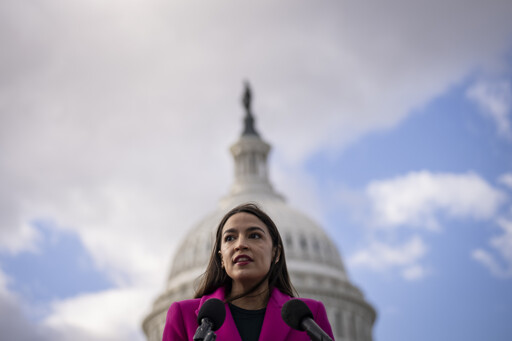Summary
Representative Alexandria Ocasio-Cortez warned that Trump’s mass deportation policy could lead to labor shortages and higher grocery prices.
Experts say agriculture, construction, and healthcare will be hardest hit, with farm output losses estimated between $30 and $60 billion.
Deportations could cost the U.S. economy up to $88 billion annually.
AOC argued that immigrant labor is vital to economic stability, urging Congress to pursue immigration reform.



Farms are just going to take it on the chin. They’re losing their labor with the mass deportations and they’re losing a hilariously large buyer of food with USAID being shut down.
So who’s ready for the new price on food?
And they’ll blame Democrats. And the Democratic Party won’t combat the misinformation because they suck at messaging.
The Democratic party in the US is so wimpy. The one thing I respect of Republicans is that they fight for what they want. Often it’s dirty, bad-faith, bottom-dwelling (and sometimes straight up illegal) behavior, but it gets results in a country this dumb and gullible. Democrats need to learn to stop compromising on things they care about.
IMHO, Democrats have gotten much better with their messaging over the past decade. People just don’t pay attention because diligently solving problems with substantial plans that take years to show effects isn’t sexy or exciting.
I stay pretty keyed in to what’s going on in congress, but I have to put effort into that. It seems like all the algorithms constantly want to shift my content to paying attention to all the crazy shit the GOP is up to and I’m constantly catching and stopping myself from getting sucked into rage porn.
Yeah maybe… But they’re also so bad at even just pointing out the horrible shit Republicans are constantly doing.
You’re not looking. “Now This!” and Cspan are two great YouTube channels for democratic media coverage. Dems are constantly calling Republicans out on stuff. Cspan is extra cool because they post full, unedited hearings so you get to see dems actually try to govern while the alt-righters behave like children, yell, and posture for their 30 second media clips, then sit back down and stare at their phone until it’s time to talk again.
They are OK at messaging, it’s just for people only consume conservative propaganda, because dems has to be bounded by truth, and cons can say whatever they want, and truth is just isn’t as exciting
Yup. I can see that one a mile out.
Reminder, losing a large purchasing segment decreases demand, which lowers prices until the market adjusts. I.e., it frees up agricultural output that they have to sell, which they’ll lower prices to make sell to other buyers (domestically or internationally).
It depends on the market. If producing less food with the same resources costs more, prices will rise–especially on large commercial farms, which dominate the U.S. agricultural sector.
For example, a farm designed to grow 10,000 acres of beans can’t simply reduce production to 5,000 acres due to lower demand and expect prices to drop. The unused 5,000 acres still incur costs, and farmers won’t absorb that loss–they’ll pass it on as higher prices.
Additionally, some grocery chains buy produce through futures contracts. If these chains sell their futures for a profit, they secure produce at a bargain, cutting into farming profits. This discourages farmers from offering futures in subsequent seasons, forcing grocers to buy bulk products at higher prices instead of securing cheaper futures.
The part you quoted from what I said was in reference to an agricultural buyer being lost. There are other reasons to anticipate the costs of inputs increasing, but I’m going through analyzing factor by factor (descending analysis) and all of a sudden we’re jumping back up to the top to talk about something else.
Re: grocery chains (not USAID) and futures contracts - not sure how this ties in either, we’re talking about USAID, which AFAIK does procurement through a bidding process for direct purchases, not via futures.
So the issue is, that those are two different categories. USAID tends to be food stuff that the US massively over produces, dairy, corn, soy, ect. These are all categories that are highly automated and don’t require much labor (relative to other categories)
The places where the most migrant labor is utilized are things like fruits, vegetables, and meat processing. stuff that can’t be mechanized to the same degree as corn or milk. Stuff that doesn’t tend to get exported as part of USAID because it is in demand in the US.
14th amendment and no not happy about it.
True, well, I mean, take the effects I described and apply them to the respective agricultural sectors. We will very likely see price increases in fresh produce and some price decrease in corn, soy, wheat, dairy, etc. (I say “some” because the actual global demand for food hasn’t decreased, rather, the purchasing power has been decreased because some subsidization has been lost due to USAID absence).
So, thing is USDA guarantees a minimum price for stuff like corn and dairy, paying the difference between the actual market price and the minimum price to farmers. So the market price for them will drop but production won’t, and chances are, most of the stuff will end up getting thrown out or used in utterly absurd way. Closing USAID just removes a potential useful outlet for the surplus. Rather than corn getting used for subsidizing food costs in other countries, it’ll be up getting used to make potting soil, gasoline and dry wall. Not because it makes economic sense to do so, but because the government will pay the economic losses that are inherent in such wasteful use cases.
The distributors will lower prices. Farmers will get paid pennies for what would be dollars. Farmers don’t sell their product directly. They get screwed before the consumer gets screwed. In this kind of a cycle prices drop in the short term, but as farmers can’t afford to plant as much going forward, there’s a supply crunch next season. The government used to do a lot to manage this cycle and smooth it out, by literally buying product.
No big deal in the long term though right? Well except we don’t have a competitive distributor or grocery market anymore. So when that crunch hits those prices are going up and they’re going to stay up. For reference check the recent greedflation that happened.
Worse there is a real risk of a dust bowl effect. Farmers who are strapped for cash don’t want to spend money setting their fields up to fallow properly. So the summer hits and the crops that are planted get buried in all that dust. Making the supply crunch even worse.
Then in a normal situation we’d still have the global supply chain to fall back on. But there’s a very good chance that food is going to have tariffs on it.
Farming isn’t like making a widget in a factory.
I know I’ve started buying some MREs…
It’ll take a minute to blow up into a full on crisis though. And please tell me you mean dehydrated food. MREs are … Uh… Not great.
I’m not sure what your main point is here. I was responding to you grouping together a labor shortage and a demand shock as - from what it sounded like - a reason to expect high prices. But demand shocks lower prices on the consumer side of food production, as opposed to raising them, because the food at that point exists, and whoever has it needs to sell it, more desperately than they were before.
My main point is this is well beyond the supply/demand chart you get in Econ 101. That more applies to distributors and grocers than it does to farmers. In most places the farmers aren’t in control of the price. The distributors are. This is how you get things like Dairy Farmers disposing of literal tons of milk. It was more expensive to send it than they would have been paid for it. In other words the price dropped so low it wasn’t worth selling it.
Of course that has knock on effects. That farm doesn’t magically get more money next year so their operations are constrained. Grain is worse than Dairy because it can be siloed for literal years. That means the glut will take years to resolve. Years with low or no income for grain farmers.
Are you seeing the problem yet?
No, I’m still not really sure what you’re trying to say. Your original post was about the price to consumers.
And as for the relationship between farmers and distributors, that really depends on the specifics of the purchasing agreements they enter into.
Dude I’m not going to start repeating myself. You have the chain of events that causes higher consumer prices, you just don’t want to admit it’s likely unless the government steps in to prevent it.